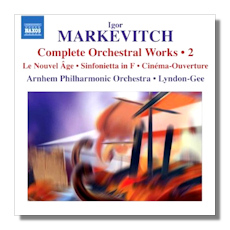
The Internet's Premier Classical Music Source
Related Links
Search Amazon
Recommended Links
Site News
 CD Review
CD Review
Summary for the Busy Executive: Three strong works.
At the age of 16, Igor Markevitch played his compositions for Diaghilev and became the impresario's next musical sensation. He vaulted in a single bound to the forefront of Parisian artistic circles. Milhaud wrote appreciations of his scores, and eventually Igor Stravinsky himself, notoriously prickly toward other composers (particularly toward potential rivals), gave his approval. However, by 29, Markevitch had given up composition in favor of conducting, despite having earned an extremely high reputation. Nadia Boulanger, Athena to Modern composers and his teacher, lamented his decision. The three scores on the program argue for Markevitch's importance as an interwar composer.
In four movements, the Sinfonietta, the finale of which Markevitch played for Diaghilev, announced a new kid in town, from the fanfares of the very first movement. The music shows affinities with Milhaud in its fondness not only for polytonality, but for polyrhythms. Yet it never merely imitates. Markevitch is attracted to ostinatos and to melodies that sneak back upon themselves. The second movement sandwiches a forlorn minuet between an allegro that sounds a bit like Kurt Weill. To me, the minuet represents Markevitch at his most characteristic – repetition in the service of ritualism. The following slow movement takes a theme reminiscent of Russian Orthodox chant. One also hears a hollow sparseness in the orchestration, another device that became characteristic. The finale appropriates jazz-like phrasing mainly through the use of both ostinato of three pulses against four pulses as well as of the break up of a 4/4 measure into two beats of 3/8 followed by a 2/8. There's a probably unconscious nod to Stravinsky's Firebird and to The Rite of Spring when the music's small notes gather into broad tunes – both scores, despite their age, still influential among composers in Twenties Paris. The piece overall comes across like the work of a very smart kid having the time of his life showing off.
Markevitch originally intended the Cinéma-Ouverture, according to the liner notes, as part of a score for a dance film by Leonid Massine on Strauss's "Blue Danube" Waltz. The rest of the music was to be Markevitch's arrangement of Strauss, but the film never got made. The arrangement never got written. Lyndon-Gee's liner notes claim that parts of the "Blue Danube" became thematic material for the overture, but damned if I can hear any of it, despite a brief passage in waltz time. The overture begins with a quick, machine-like march. Stravinsky peeks in with Markevitch's inclusion of a cimbalom, also featured prominently in Renard. Markevitch also bows to Satie's Parade, with intrusions of sirens, buzzers, car horns, and slide whistles. For me, what stand out are the insistence on the rhythmic independence of each voice and the thrusting of rough, short ostinato into the foreground, almost as a melodic element.
Le Nouvel Âge appeared in 1937 and thus counts as a late work. It was to have been an oratorio, with a libretto by poet Edward James – a counterpart to Markevitch's Le Paradis perdu. However, the two fell out over James's affair with Markevitch's wife, and the libretto was never realized. Markevitch decided to turn the work into a tone poem on his own libretto. However, the composer had a fatal attraction for theosophic poetic blather and came up with an embarrassing, nonsensical scenario. Fortunately, it didn't damage the score, widely considered one of his masterpieces, and so the music appears to advantage in a purely orchestral concert setting. We needn't bother with the plot. The score has three movements: "Ouverture," "Adagio," and "Hymne." After a brief, quiet opening of strings in octaves, the orchestra erupts with a hymn to the Machine Age, a genre popular in the Twenties, with works like Honegger's Pacific 231, Antheil's Ballet Mécanique, Prokofieff's Le pas d'acier, and Mosolov's Iron Foundry. The mechanistic riffs – thuds from the bass drum, the snares' taradiddles, the blaring brass – of the Sinfonietta and the Cinéma-Ouverture achieve their greatest expressive power in a Markevitch score. For me, the Adagio counts as the most extraordinary movement, achieving an intense, hypnotic near-glacial movement. The "Hymne" begins as another paean to the Jazz Age but slows to the music of the Adagio. The trumpets and percussion at high blast burst in again, and after a passage of many competing rhythms, the piece ends on a blaring "jazz" seventh.
This entry stands among the strongest of Naxos's seven-volume Markevitch series. As always, Lyndon-Gee and the Arnhemers play with dedication and spirit.
Copyright © 2012, Steve Schwartz.






















